Injectable hyaluronic acid-dextran hydrogels and effects of implantation in ferret vocal fold
- PMID: 20151459
- PMCID: PMC4070526
- DOI: 10.1002/jbm.b.31593
Injectable hyaluronic acid-dextran hydrogels and effects of implantation in ferret vocal fold
Abstract
Injectable hydrogels may potentially be used for augmentation/regeneration of the lamina propria of vocal fold tissue. In this study, hyaluronic acid (HA) and dextran were chemically modified and subsequently crosslinked via formation of hydrazone bonds in phosphate buffer. Swelling ratios, degradation, and compressive moduli of the resulting hydrogels were investigated. It was found that the properties of HA-dextran hydrogels were variable and the trend of variation could be correlated with the hydrogel composition. The biocompatibility of three injectable HA-dextran hydrogels with different crosslinking density was assessed in the vocal fold region using a ferret model. It was found that HA-dextran hydrogels implanted for three weeks stimulated mild foreign-body reactions. Distinct tissue-material interactions were also observed for hydrogels made from different formulations: the hydrogel with the lowest crosslinking density was completely degraded in vivo; while material residues were visible for other types of hydrogel injections, with or without cell penetration into the implantation depending on the hydrogel composition. The in vivo results suggest that the HA-dextran hydrogel matrices can be further developed for applications of vocal fold tissue restoration.
(c) 2010 Wiley Periodicals, Inc.
Figures
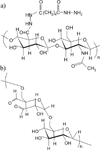
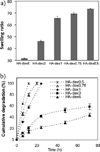
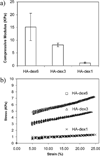
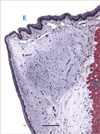
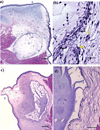
Similar articles
-
Biocompatibility and Viscoelastic Properties of Injectable Resilin-Like Polypeptide and Hyaluronan Hybrid Hydrogels in Rabbit Vocal Folds.Regen Eng Transl Med. 2019 Dec;5(4):373-386. doi: 10.1007/s40883-019-00094-6. Epub 2019 Feb 27. Regen Eng Transl Med. 2019. PMID: 33829078 Free PMC article.
-
In Vivo engineering of the vocal fold ECM with injectable HA hydrogels-late effects on tissue repair and biomechanics in a rabbit model.J Voice. 2011 Mar;25(2):249-53. doi: 10.1016/j.jvoice.2009.10.003. Epub 2010 Apr 24. J Voice. 2011. PMID: 20456912 Free PMC article.
-
Retention of Human-Induced Pluripotent Stem Cells (hiPS) With Injectable HA Hydrogels for Vocal Fold Engineering.Ann Otol Rhinol Laryngol. 2017 Apr;126(4):304-314. doi: 10.1177/0003489417691296. Epub 2017 Feb 12. Ann Otol Rhinol Laryngol. 2017. PMID: 28290232
-
Hyaluronic acid hydrogels for vocal fold wound healing.Biomatter. 2013 Jan-Mar;3(1):e23799. doi: 10.4161/biom.23799. Epub 2013 Jan 1. Biomatter. 2013. PMID: 23507923 Free PMC article. Review.
-
A Review of Hyaluronic Acid and Hyaluronic Acid-based Hydrogels for Vocal Fold Tissue Engineering.J Voice. 2017 Jul;31(4):416-423. doi: 10.1016/j.jvoice.2016.11.014. Epub 2017 Mar 2. J Voice. 2017. PMID: 28262503 Free PMC article. Review.
Cited by
-
Incorporation of types I and III collagen in tunable hyaluronan hydrogels for vocal fold tissue engineering.Acta Biomater. 2019 Mar 15;87:97-107. doi: 10.1016/j.actbio.2019.01.058. Epub 2019 Jan 30. Acta Biomater. 2019. PMID: 30708064 Free PMC article.
-
Designing robust chitosan-based hydrogels for stem cell nesting under oxidative stress.Bioimpacts. 2022;12(1):57-64. doi: 10.34172/bi.2021.23831. Epub 2021 Oct 16. Bioimpacts. 2022. PMID: 35087717 Free PMC article.
-
In vitro evaluation of a basic fibroblast growth factor-containing hydrogel toward vocal fold lamina propria scar treatment.J Biomed Mater Res B Appl Biomater. 2018 Apr;106(3):1258-1267. doi: 10.1002/jbm.b.33936. Epub 2017 Jun 5. J Biomed Mater Res B Appl Biomater. 2018. PMID: 28580765 Free PMC article.
-
Stem Cell-Based Tissue-Engineered Laryngeal Replacement.Stem Cells Transl Med. 2017 Feb;6(2):677-687. doi: 10.5966/sctm.2016-0130. Epub 2016 Sep 9. Stem Cells Transl Med. 2017. PMID: 28191770 Free PMC article.
-
Tissue engineering-based therapeutic strategies for vocal fold repair and regeneration.Biomaterials. 2016 Nov;108:91-110. doi: 10.1016/j.biomaterials.2016.08.054. Epub 2016 Sep 2. Biomaterials. 2016. PMID: 27619243 Free PMC article. Review.
References
-
- Lee KY, Mooney DJ. Hydrogels for tissue engineering. Chem Rev. 2001;101:1869–1879. - PubMed
-
- Hoffman AS. Hydrogels for biomedical application. Adv Drug Deliv Rev. 2002;43:3–12. - PubMed
-
- Griffith LG. Polymeric biomaterials. Acta Mater. 2000;48:263–277.
-
- Prestwich GD, Shu XZ, Liu Y, Cai S, Walsh JF, Hughes CW, Ahmad S, Kirker KR, Yu B, Orlandi RR. Injectable synthetic extracellular matrices for tissue engineering and repair. Adv Exp Med Biol. 2006;585:125–133. - PubMed
-
- Khan Y, Yaszemski MJ, Mikos AG, Laurencin CT. Tissue engineering of bone: Material and matrix considerations. J Bone Joint Surg Am. 2008;90(Suppl 1):36–42. - PubMed
Publication types
MeSH terms
Substances
Grants and funding
LinkOut - more resources
Full Text Sources
Other Literature Sources

